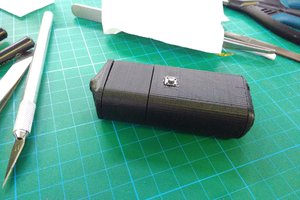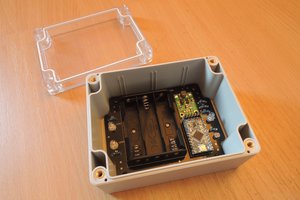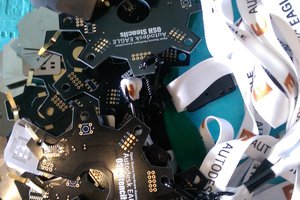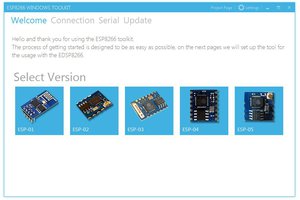Common Parts Library
It is a set of 300 most commonly used electronic components for connected device products.
It is a set of 300 most commonly used electronic components for connected device products.
To make the experience fit your profile, pick a username and tell us what interests you.
We found and based on your interests.
Create an account to leave a comment. Already have an account? Log In.
Hi Stefan,
Thanks for your recommendations! Would possibly add these in the coming iterations. Currently we are working on releasing the CPL for Production https://octopart.com/common-parts-library version. Is there anything in particular that you would like to see in it? One of the ideas we had was to add country specific information for each part - such as X part is available in China, Y part is available in US etc.
Glad that you liked the descriptions!
Sanket
Hi Sanket,
glad to hear it, I just hope to be of help.
From taking another look at CPL for Prod. I saw that there are no PICs in the microcontroller category. I'm pretty new to PICs so I don't know what the most popular model to add to the list would be but I think it'd be good to have some. Maybe the APA102 would also be a good addition, just to have an alternative to the WS2812. Another thing I'm missing are rotary encoders in the switches/buttons categories.
In terms of features for the site: I like the clean look of the list but maybe something like the starting price would be useful information to see right away. I think it makes sense that if you use the site to order (or go to the distributors site to order) that it would be possible to only display parts that are available from your favorite distributor.
Just some ideas, hope this is useful to you.
Stefan
Hi Stefan,
Thanks for your input on CPL for Production! I really like the idea on choosing your favorite distributor and the CPL list just showing the parts from that distributor along with price and quantity.
Another way this can be implemented is putting flags of different countries next to each part. So if you click on US flag, US distributors show up. If you click on China flag, Chinese distributors show up and so on.
What do you think about that?
Yeah, that would be a great way of finding the cheapest local supplier for that part, I could really see myself using this! You should also consider that big suppliers (Farnell, Mouser, ...) might have multiple warehouses from where they ship so you might want to display them for multiple countries.
To me, part of the purpose of CPL is to have a supply of the parts on hand so you'd buy those parts in bulk from the cheapest supplier and another part, of course, is if other people are using CPL they can easily copy the project. But at lower quantities (completely disregarding that I might have a supply of the parts already) I'd be interested to see from which supplier I can get all of the parts for the best price since at lower quantities it'll cost quite some shipping when ordering from multiple suppliers. I realize that this would require some form of shopping cart to keep track of the selected parts which might be quite some work to add to the site but in my opinion this would be a nice feature. Again, I'm just throwing around ideas, just tell me if it isn't feasible ;)
That's a valid point. :) You'd want to buy parts from the same distributor as much as possible: either to save shipping costs or just because you tend to like one over another. A shopping cart that can handle shipping is definitely on our roadmap but that might be further away as it is not easy to calculate weight and other factors.
One of the questions I had was: when you are doing your own board design work, do you typically use parts available in North American supply chain and then try to change to Chinese replacements (which are cheaper)? Would it be helpful if you knew what are the Chinese replacements widely used by CMs in China in the first stage of design itself?
Another thing we have been thinking about is showing the information in graphical formats. Having X axis show 1uF, 10uF, 100uF etc and & Y axis show package options such as 0402, 0603, 0805 etc; and showing the pricing and quantity info in the graph. What do you think about this? What might you want to see in such a graph?
Well, most of my projects are one-offs so large volume considerations like switching supply chains don't really play into sourcing my components. However, knowing what components CMs use would indeed be very helpful if I was planning on doing a big(ger) run.
Yeah, graphs or tables would be quite handy, especially for passives. I find the long lists (of e.g. resistors) quite unwieldy so if I could first select some parameters (e.g. package size and tolerance) and then select a resistor from a table that shows the power ratings for all the resistance values that would speed up the process, I think. You could also switch it around and select the power rating and tolerance first, for example.
Regarding your specific example, I don't think comparing prices of different package size is such an important consideration, to be honest. Because if you can afford it (e.g. power-wise) why wouldn't design with smaller components which are cheaper and take up less board space. But as I said, there probably are some functions that would benefit from alternate ways to display the data or some filtering.
If at some point you could factor in shipping costs and the influence weight hast on it, that would be amazing!
Thanks Stefan on the input! Some of these ideas are on the roadmap, stay tuned!
Thanks for your comment!
Graphical approach is definitely interesting esp. to deliver a context about choosing a part - something which tables can't do well.
We wrote a blog on How to Select a Resistor (https://blog.octopart.com/archives/2016/04/how-to-select-a-resistor) - we will put some of these recommendations for parts in a form of graph with pricing and qty info.
This is a follow-up of How to Select a Capacitor (https://blog.octopart.com/archives/2016/03/how-to-select-a-capacitor)
Cool, I'll check out the posts when I have a moment.
Hi Stefan! Thanks for your input on CPL for prototyping. These parts have been added in the latest version: https://octopart.com/common-parts-library/prototyping
Also, we have updated the current library and integrated Seeed Studio's Open Parts Library into it: www.octopart.com/cpl It supports single click download of symbols and footprints, and comes with real time pricing and availability info!
Any initial thoughts?
Hey Sanket,
wow, those are a lot of changes and additions, great job! I looked through the lists for prototyping and production and can't think of anything that's missing. One small bug though: The links to Seeed are not taking me to the product pages like with the other distributors.
Hi Stefan,
Thanks! :) We will be releasing the library on GitHub soon in YAML and JSON format. Hopefully that will make it easier for users to access the data and use it.
As for Seeed links, we are working to fix them.
-Cheers!
Is the goal to create a dev kit?
Getting valid models for KiCAD or Eagle also takes up a lot of time especially if you are doing the board design work in parallel to ordering the parts. Just having valid footprints would be an enormous time/expense saver.
How much would a kit cost?
Hi Randy, we already have footprints for all the parts thanks to SnapEDA for KiCad, Eagle and Altium. Check it out at: http://www.snapeda.com/libraries/common-parts-library/
We are getting lots of questions around kits. We are targeting a dev kit for a price of around $150: it will include Wi-Fi modules, all popular MCU chips, common sensors, regulators, motor drivers and the supporting passives. Would that be something you might be interested to get hold of?
The price point is within reach, but above the $100 level I get a little more demanding of kits. I don't know how many I've seen that have very large part count but when you look at the BOM, the vast majority of that number is made up of passives. I have axial resisters and ceramic bypass caps out the wazoo. I dont usually prototype with SMD devices. So if your kit is filled with SMD and BGA devices it will need breakout boards for the breadboards.
I'd need to see a detailed BOM before answering.
Hi Randy, yes the library is mostly SMD components which is for designing and manufacturing end-products. In the kit, however, we will be doing through-hole/ dev board versions of the chips. As for the cost, the whole library would cost $150, which would be ideal for a lab or a hackathon where the end application is not certain. However, knowing the application would definitely bring the cost down. Do you have a particular application that you would get the kit for?
Well, the next greatest coolest thing of course!!!
Wifi net communication between IoT devices. Distance measuring between nodes. DC Motor control and stepper motor control. ESC control of Brushless motors. Video analysis. Smart battery charging.
But really you don't always know where a project will take you, do you? That's the appeal of a dev kit. To cut out the delivery lag and get a good start in a good direction with some proven components.
That's a good point. A dev kit with popular dev boards and driver break-outs, through hole passives, power management components etc.: that should be perfect for a general case. Throw in some application notes for each, and design example links and we are good to go. Do you think that might meet your end-goal?
I think this approach would be best:
https://hackaday.io/project/6332-breadboard-widgets
Continuing with that thought a dev kit would consist of widgets for each device. If the widget was pre-assembled, then SMD is easiest. If through-hole, then the widget would be a through hole kit. Part SMD and part through-hole never ends well.
Application notes and design links for the widgets? Fantastic! All widgets open source hardware? Required.
Widgets? Thats interesting. There are numerous manufacturers like Polulu and Robot Shop etc. who are building their own break-outs for voltage regulators, motor drivers etc. An assembly of some of their popular boards for different applications makes sense. Add in batteries, some sensor boards and supporting peripherals: and we have a dev kit!
I started using that approach for a while.
One thing I would have done different is standardize how I connect them. I used whatever was available. If I did it all over I would have pins on the widget for power and sockets for signal, but so many have the two mixed on the same connector that I don't know if that is practicle.
Yeah thats a common problem with dev boards. The incompatibility of pins with each other. For now we are just going to be building a dev kit with what is available out there. In future, we can consider making the boards compatible with each other.
We are planning to ship some dev kits out soon (at a discounted price!), you can get one too.
Thanks Zach. Vending machine would be perfect wouldn't it. :)
Would you be interested in getting a kit of all the components?
Great list! Throw this stuff in a vending machine in NE Mpls and I'll be your biggest customer!
Become a member to follow this project and never miss any updates
By using our website and services, you expressly agree to the placement of our performance, functionality, and advertising cookies. Learn More

 Akshat Wahi
Akshat Wahi
 Ondřej Petrlík
Ondřej Petrlík
 technolomaniac
technolomaniac
 Thomas
Thomas
Hey, following up on my reply from earlier, here are some suggestions for common-parts-library/prototyping:
I mainly use the Arduino Pro Mini and Pro Micro because I like the small form factor. I also quite like the Pro Trinket.
An alternate USB-to-Serial adapter might be a good idea, 15$ seems a bit expensive. I mostly use CP2102 based modules from eBay, not sure where else to get them though.
I think some buck converters would also be great. Adafruit has those TSR124xx modules and another one based on the MP2307. I have some MP2307 modules from eBay that are not particularly breadboard compatible but one can make it work.
For testing I like to start with just a single WS2812(B), Adafruit and SparkFun should have such breakouts.
A dedicated logic analyzer might be a good addition to the test equipment section. Obviously Saleae comes to mind but on my budget I'd probably go for the Logic Pirate or Open Workbench Logic Sniffer from Dangerous Prototypes.
And finally I'd suggest something like the diagonal flush cutters, e.g. from Adafruit, for the tools section.
Btw: Good job on the descriptions in the platforms and interface boards sections, adding this additional information is a nice touch.